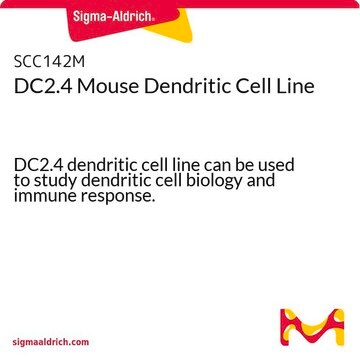SCC134
IMG Mouse Microglial Cell Line
Mouse
Sinonimo/i:
Immortalized microglial cells
About This Item
Prodotti consigliati
product name
IMG Mouse Microglial Cell Line, IMG microglial cells recapitulate key features of microglial cell activation and may be used to study neuroinflammatory responses underlying Alzheimer′s disease.
Origine biologica
mouse
Livello qualitativo
tecniche
cell based assay: suitable
Condizioni di spedizione
ambient
Categorie correlate
Descrizione generale
Reference:
1. McCarthy RC, Lu DY, Alkhateeb A, Gardeck AM, Lee CH and Wessling-Resnick M (2016). Characterization of a novel adult murine immortalized microglial cell line and its activation by amyloid-beta. J. Neuroinflammation 13: 21
Descrizione della linea cellulare
Applicazioni
Immune Response
Inflammation & Immunology
Neuroscience
Neurodegenerative Diseases
Neuroinflammation & Pain
Qualità
• Cells are tested negative for infectious diseases by a Mouse Essential CLEAR panel by Charles River Animal Diagnostic Services.
• Cells are verified to be of mouse origin and negative for inter-species contamination from rat, chinese hamster, Golden Syrian hamster, human and non-human primate (NHP) as assessed by a Contamination Clear panel by Charles River Animal Diagnostic Services.
• Cells are negative for mycoplasma contamination.
Stoccaggio e stabilità
Codice della classe di stoccaggio
12 - Non Combustible Liquids
Classe di pericolosità dell'acqua (WGK)
WGK 1
Punto d’infiammabilità (°F)
Not applicable
Punto d’infiammabilità (°C)
Not applicable
Certificati d'analisi (COA)
Cerca il Certificati d'analisi (COA) digitando il numero di lotto/batch corrispondente. I numeri di lotto o di batch sono stampati sull'etichetta dei prodotti dopo la parola ‘Lotto’ o ‘Batch’.
Possiedi già questo prodotto?
I documenti relativi ai prodotti acquistati recentemente sono disponibili nell’Archivio dei documenti.
Il team dei nostri ricercatori vanta grande esperienza in tutte le aree della ricerca quali Life Science, scienza dei materiali, sintesi chimica, cromatografia, discipline analitiche, ecc..
Contatta l'Assistenza Tecnica.







